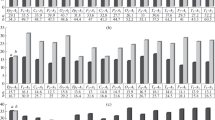Summary
The effect of caffeine (single oral doses of 200 mg and 400 mg) on the CNS was tested under resting conditions and while performing a concentration performance test in a placebo-controlled pilot study on ten healthy males. The EEG was evaluated quantitatively by spectral analysis with a Computer Aided Topographical Electro En-cephalo Metry system. Comparison of the averaged frequency content revealed a clear difference between the change in the functional state of the brain due to the mental arithmetics, on the one hand, and the caffeine effect, on the other. Both states of altered brain activity were reflected in a particular topographical distribution of the frequency change with respect to a frontal-occipital accentuation. Comparison of the two periods of mental arithmetics in the absence or presence of caffeine showed a tendency to concentration-dependent differences from each other. Administration of 200 mg and 400 mg caffeine in the relaxed state effected the decrease in spectral power in the theta and alpha ranges. The concentration performance test without caffeine effected decreases in power in the alpha range in frontal to parietal cortex and enhanced theta power in frontal and occipital regions and the alpha power in occipital cortex. The caffeine-dependent decrease in theta power and the decrease in delta power seen under relaxation conditions after 400 mg are not observed during the concentration performance test in the presence of caffeine.
Similar content being viewed by others
Abbreviations
- KLT:
-
Konzentrationsleistungstest (concentration performance test)
References
Benowitz NL (1990) Clinical pharmacology of caffeine. Ann Rev Med 41:277–288
Bruns RF, Lit GH, Pugsley TA (1987) Adenosine receptor subtypes: binding studies. In: Gerlach E, Becker BF (eds) Topics and perspectives in adenosine research. Springer, Berlin Heidelberg New York, pp 59–73
Daly JW, Bruns RF, Snyder SH (1981) Adenosine receptors in the central nervous system: relationship to the central actions of methylxanthines. Life Sci 28:2083–2097
Daly JW, Butts-Lamb P, Padgett W (1983) Subclasses of adenosine receptors in the central nervous system: interaction with caffeine and related methylxanthines. Cell Mol Neurobiol 3:69–80
Düker H, Lienert GA (1965) Der Konzentrationsleistungstest (KLT). Hogrefe, Göttingen
Etevenon P, Peron-Magnan P, Boulenger JP, Tortrat D, Guillot S, Toussaint M, Gueguen B, Deniker P, Zarifian E (1986) EEG cartography profile of caffeine in normals. Clin Neuropharmacol 9:538–540
Fredholm BB (1985) On the mechanism of action of theophylline and caffeine. Acta Med Scand 217:149–153
Fredholm BB (1985) Adenosine and the central catecholamine transmission. In: Stefanovich VK, Rudolphi K, Schubert P (eds) Adenosine: receptors and modulation of cell function. IRL, Oxford
Fredholm BB, Hedqvist P (1980) Modulation of neurotransmission by purine nucleotides and nucleosides. Biochem Pharmacol 29:1635–1643
Green RW, Haas HL, Herrmann A (1985) Effect of caffeine on hippocampal pyramidal cells in vitro. Br J Pharmacol 85:163–169
Grünewald G, Simonova O, Creutzfeldt O (1968) Differentielle EEG-Veränderungen bei visuomotorischen und kognitiven Tätigkeiten. Arch Psychiatr Nervenkr 212:46–69
Haas HL, Green RW (1988) Endogenous adenosine inhibits hippo-campal CAI-neurones: further evidence from extra-and intra-cellular recordings. Naunyn-Schmiedebergs Arch Pharmacol 337:561–565
Hofmann C, Spüler M, Hellmann H, Dimpfel W (1990) Design and implementation of a real time system for Computer Aided Topographical Electroencephalometry. Paper on International Conference on Medical Informatics and Medical Information - International Symposium on Mathematical Approaches to Brain Functioning Diagnostics, September 3–7, Prague
Hollins C, Stone TW (1980) Adenosine inhibition of GABA release from slices of rat cerebral cortex. Br J Pharmacol 69:107–112
Jasper HH (1958) The ten-twenty electrode system of the international Federation. Electroencephal Clin Neurophysiol 10:371–375
Karkos J (1990) Purinerge Neuromodulation. Fortschr Neurol Psychiatr 58:33–42
Lee KS, Reddington M (1986) Autoradiographic evidence for multiple CNS binding sites for adenosine derivatives. Neuroscience 19:535–549
Lewin E, Bleck V (1979) Uptake and release of adenosine by cultured astrocytoma cells. J Neurochem 33:365–367
Lieberman HR, Wurtman RJ, Emde GG, Roberts C, Coviella G (1987) The effects of low doses of caffeine on human performance and mood. Psychopharmacology 92:308–312
Lieberman HR, Wurtman RJ, Emde GG, Lopez F, Coviella G (1987) The effects of caffeine and aspirin on mood and performance. J Clin Psychopharmacol 7:315–320
Mumford GK, Holtzman SG (1991) Qualitative differences in the discriminative stimulus effects of low and high doses of caffeine in the rat. J Pharmacol Exp Ther 258:857–865
Phillis JW, Wu PH (1981) The role of adenosine and its nucleotides in central synpatic transmission. Prog Neurobiol 16:187–239
Rappelsberger P, Pockberger H, Petsche H (1986) Computer aided EEG analysis — evaluation of changes during cognitive processes and topographic mapping. EDV Med Biol 17:45–53
Rockstroh B, Elbert T, Birbaumer N, Lutzenberger W (1982) Slow Brain Potentials and Behavior. Urban & Schwarzenberg, München Wien Baltimore
Saletu B, Anderer P, Kinsberger K, Grünberger J (1987) Topographic brain mapping of EEG in neuropsychopharmacology. II. Clinical applications (pharmaco EEG imaging). Methods Find Exp Clin Pharmacol 9:385–408
Sawyer DA, Julia HL, Turin AC (1982) Caffeine and human behavior: arousal, anxiety and performance effects. J Behav Med 5:415–439
Simonov PV (1982) Höhere Nerventätigkeit des Menschen. Motivationale and emotionale Aspekte. Volk and Gesundheit, Berlin
Snyder SH (1985) Adenosine as a neuromodulator. Annu Rev Neurosci 8:103–124
Stoner GR, Skirboll LR, Werkman S, Hommer DW (1988) Preferential effects of caffeine on limbic and cortical dopamine systems. Biol Psychiatry 23:761–768
Svedmyr N (1980) Long term theophylline therapy — proceedings of a symposium held in Copenhagen 24th September 1979. Eur J Resp Dis 61 [Suppl 109]:134–136
Williams M, Jarvis MF (1988) Adenosine antagonists as potential therapeutic agents. Pharmacol Biochem Behav 29:433–441
Author information
Authors and Affiliations
Rights and permissions
About this article
Cite this article
Dimpfel, W., Schober, F. & Spüler, M. The influence of caffeine on human EEG under resting condition and during mental loads. Clin Investig 71, 197–207 (1993). https://doi.org/10.1007/BF00180102
Received:
Revised:
Accepted:
Issue Date:
DOI: https://doi.org/10.1007/BF00180102



